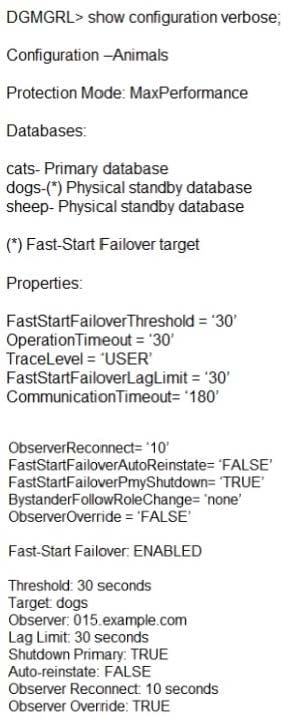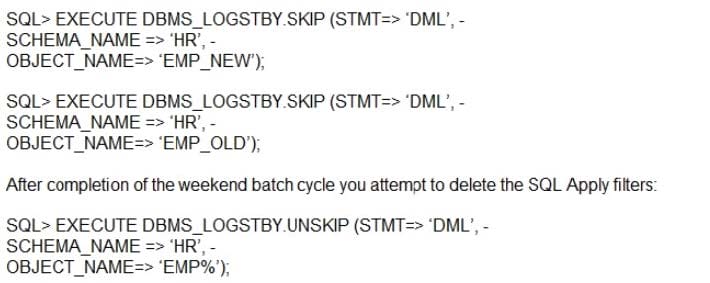Exam Details
Exam Code
:1Z0-066Exam Name
:Oracle Database 12c: Data Guard AdministratorCertification
:Oracle CertificationsVendor
:OracleTotal Questions
:204 Q&AsLast Updated
:Mar 26, 2025
Oracle Oracle Certifications 1Z0-066 Questions & Answers
-
Question 51:
Which three are required in order to use Real-Time Query without lagging behind the primary?
A. There must be standby redo logs on the standby database
B. There must be standby redo logs on the primary database.
C. The primary must ship redo asynchronously.
D. COMPATIBLE must be set to 11.1.0 or higher.
E. Real-Time apply must be enabled on the standby.
-
Question 52:
Examine the Data Guard configuration after an accidental switchover to Sheep: Which three will be true after a switchover to Dogs?

A. Sheep will be a disabled logical standby database.
B. Sheep will be an enabled logical standby database.
C. Cats will be a disabled physical standby database that can be manually enabled.
D. Cats will be an enabled physical standby database.
E. Dogs will be the primary database.
-
Question 53:
Which three are benefits of using the Data Guard Broker to manage standby databases?
A. it simplifies physical standby database creation
B. It provides an easy failover capability using a single command.
C. it coordinates database state transitions and updates database properties dynamically.
D. it automatically changes database properties after the protection mode for a configuration is changed
E. It provides an easy switchover capability using a single command.
F. It simplifies logical standby database creation.
-
Question 54:
Examine the Data Guard configuration: Configuration Status: SUCCESS

Which two are true?
A. The observer must run on host ol5.example com and is currently not running.
B. The observer will reinstate Sheep automatically after a failover, if required.
C. The observer will mark another standby database as the failover target if the original failover target becomes unavailable.
D. The observer will detect if the primary database is unable to accept new connections
E. The former primary database will not be reinstated automatically alter a failover.
-
Question 55:
A Data Guard environment has this configuration and these attributes:
1.
The primary database prima is in the local region.
2.
A physical standby database physt1 is in the local region.
3.
A physical standby database physt2 is in a remote region.
4.
The primary ships redo to physt1.
5.
physt1 ships redo physt2.
6.
physt1 and physt2 have Real-Time Query enabled
A sequence has been created with this SQL statement in the primary database: CREATE SEQUENCE a NOCACHE SESSION: Which two statements are true?
A. The sequence is usable on physt1 and physt2
B. The sequence is usable on physt1 but not usable on physt2.
C. The sequence is usable on physt2 if physt1 becomes unavailable, but only if an alternative redo destination has been configured on the primary database.
D. physt2 will no longer receive redo if phystl becomes unavailable, unless LOG_ARCHIVE_DEST_n has the ALTERNATE attribute specified on the primary database.
E. physt2 will no longer receive redo if physt1 becomes unavailable, unless LOG_ARCHIVE_DEST_n has the ALTERNATE attribute specified on physt1.
-
Question 56:
On your logical standby database, you specified these rules:

Which is true regarding the execution of the UNSKIP procedure?
A. it succeeds only if SQL apply is stopped before deleting the SQL Apply filter
B. it succeeds but the SQL Apply fitters are not deleted.
C. It deletes both the SQL Apply filters.
D. it returns an error because the syntax to delete a SQL Apply filter must specify the same object names
as specified when the filter was added
E. it succeeds only if all DML statements executed on the primary have been applied on the logical standby
-
Question 57:
Which four database parameters might be affected by or influence the creation of standby databases?
A. DB_NAME
B. ARCHIVE_LAG_TARGET
C. COMPATIBLE
D. DB_FILE_NAME_CONVERT
E. DB_UNIQUE_NAME
F. FAL_SERVER
G. STANDBY_ARCH1VE_DEST
-
Question 58:
You must configure an Oracle Data Guard environment consisting of:
1. A primary database 2 One Physical Standby Database
3. One Logical Standby Database You must meet these requirements:
1.
Primary database availability should not be compromised by the availability of the standby databases.
2.
Under normal operations, transactions executed on the primary database should not commit before redo is written to disk on both the primary database and at least one standby database.
Which redo transport mode and which protection mode would you configure to meet these requirements?
A. SYNC AFFIRM and Maximum Protection
B. SYNC NOAFFIRM and Maximum Protection
C. SYNC AFFIRM and Maximum Availability
D. SYNC NOAFFIRM and Maximum Availability
E. ASYNC and Maximum Performance
-
Question 59:
Examine this list of possible steps:
1 Raise the compatibility level on both databases
2.Restart SQL Apply on the upgraded logical standby database
3 Start SQL Apply on the old primary database.
4.
Perform a Switchover to the logical standby database
5.
Upgrade the logical standby database.
6.
Upgrade the old primary database.
Which is the minimum number of steps in the correct order, to perform a rolling release upgrade of a data guard environment using an existing logical standby database and to enable the new functionality?
A. 5,2.4,3,6,1
B. 1,5,2,4,6,3
C. 5,2,4,6,3,1
D. 4,6,5,2,3,1
E. 5,2,4,1
-
Question 60:
You administer a Data Guard environment with a primary and two physical standby databases.
One of the physical standby databases is used for reporting and is on the same host as the primary database. The other physical standby database is remote, used for disaster recovery and REDO is routed to it via a
far sync instance.
Backups are offloaded to the remote physical standby.
Which three are true concerning the management of archive logs in this Data Guard configuration?
A. Archive logs on the primary database may be deleted once they are applied on all standby databases.
B. Archive logs on the primary database may be deleted once they are shipped on all standby databases.
C. The deletion policy for archive logs on the remote physical standby should be set so that archived logs are deleted once they backed up at least once on the remote physical standby database.
D. The deletion policy for archive logs on the remote physical standby should be set so that archived logs are deleted once they are applied on all standby databases.
E. Archive logs on the primary database may be deleted once they are archived locally to disk.
Related Exams:
1Z0-020
Oracle8i: New Features for Administrators1Z0-023
Architecture and Administration1Z0-024
Performance Tuning1Z0-025
Backup and Recovery1Z0-026
Network Administration1Z0-034
Upgrade Oracle9i/10g OCA to Oracle Database OCP1Z0-036
Managing Oracle9i on Linux1Z0-041
Oracle Database 10g: DBA Assessment1Z0-052
Oracle Database 11g: Administration Workshop I1Z0-053
Oracle Database 11g: Administration II
Tips on How to Prepare for the Exams
Nowadays, the certification exams become more and more important and required by more and more enterprises when applying for a job. But how to prepare for the exam effectively? How to prepare for the exam in a short time with less efforts? How to get a ideal result and how to find the most reliable resources? Here on Vcedump.com, you will find all the answers. Vcedump.com provide not only Oracle exam questions, answers and explanations but also complete assistance on your exam preparation and certification application. If you are confused on your 1Z0-066 exam preparations and Oracle certification application, do not hesitate to visit our Vcedump.com to find your solutions here.